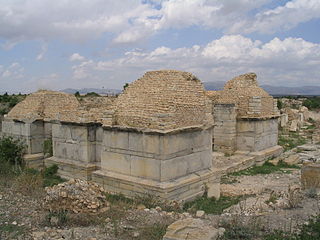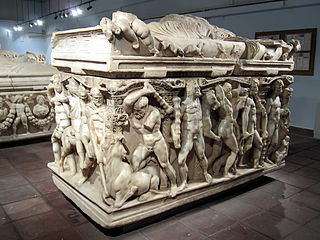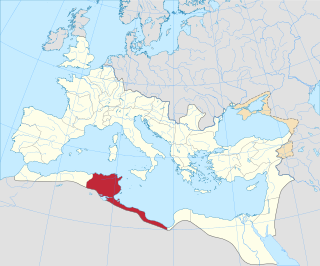Parthenia was a Roman–Berber town in the former Roman province of Mauretania Sitifensis, the easternmost part of ancient Mauretania. It was located in what is now northern Algeria.

Djémila, formerly Cuicul, is a small mountain village in Algeria, near the northern coast east of Algiers, where some of the best preserved Roman ruins in North Africa are found. It is situated in the region bordering the Constantinois and Petite Kabylie.
Apamea Myrlea was an ancient city and bishopric on the Sea of Marmara, in Bithynia, Anatolia; its ruins are a few kilometers south of Mudanya, Bursa Province in the Marmara Region of Asian Turkey.
Claudiopolis also called Ninica and Ninica Claudiopolis, was an ancient city of Cilicia. Ammianus mentions Seleucia and Claudiopolis as cities of Cilicia or of the country drained by the Calycadnus, and Claudiopolis was a colony of Claudius Caesar. It is described by Theophanes of Byzantium as situated in a plain between the two Taurus Mountains, a description that exactly corresponds to the position of the basin of the Calycadnus. Claudiopolis may therefore be represented by Mut, which is higher up the valley than Seleucia and near the junction of the northern and western branches of the Calycadnus. It is also the place to which the pass over the northern Taurus leads from Laranda. Pliny mentions a Claudiopolis of Cappadocia, and Ptolemy has a Claudiopolis in Cataonia. Both these passages and those of Ammianus and Theophanes are cited to prove that there is a Claudiopolis in Cataonia, but it is manifest that the passage in Ammianus at least can apply only to a town in the valley of the Calycadnus in Cilicia Trachea. The two Tauri of Theophanes might mean the Taurus and Antitaurus, but Hierocles places Claudiopolis in Isauria, a description that cannot apply to the places so named of Pliny and Ptolemy. The city apparently received the Roman colony name Colonia Iulia Felix Augusta Ninica and minted coins in antiquity.

Segermes is an ancient town in Tunisia. Under the Roman Empire, the town belonged to the province of Byzacena. The town is identified with ruins at Henchir Harat, Zaghouan.
Zaliche or Zaliches (Ζαλίχης) was an ancient town in the late Roman province of Helenopontus.
Motella, Metello(u)polis, or Pulcherianopolis was a city in the Roman province of Phrygia Pacatiana, in Asia Minor, probably on the site of the modern Yeşiloba (Medele).
Arabissus or Arabissos, also known as Tripotamos, was a town in ancient Cataonia, then Cappadocia, and later in the Roman province of Armenia Secunda.

Tiberiopolis was a town in the Roman province of Phrygia Pacatiana, mentioned by Ptolemy, Socrates of Constantinople and Hierocles. At various times, it was considered as part of Phrygia, Isauria, and the late Roman province of Pisidia.
Drizipara, also known as Druzipara, Drousipara, Drusipara; now Büyükkarıştıran/Büyükkarıştıran' in Lüleburgaz district, was a city and a residential episcopal see in the Roman province of Europa in the civil diocese of Thrace. It is now a titular see of the Catholic Church.
Sidi El Hani is a town and commune in the Sousse Governorate, Tunisia located at 35.67n, 10.30e. As of 2004 it had a population of 3,058. It gives its name to the largest lake of the governorate, a natural salt lake or salt pan (sabkha) in dry seasons, the Sebkhet de Sidi El Hani which is shared with between one and two other areas depending on precipitation and its maximum extent forms the official boundary with part of a third, Monastir Governorate. The town is 30 km south-west of the coast, its straightest connection being by Tunisian Railways, with a secondary connection by road, the P12 road which is a principal road to Kairouan from the A1 a few kilometres to the east. it is 19 km from Kairouan and 26 km from Raqqada.
Anineta, also known as Aninetum or Anineton, was a town of ancient Lydia or of Caria, and later of the Roman, and Byzantine empires, located in modern Turkey, the site of an ancient bishopric in and was an important site early in christianity. Anineta remains today a titular see of the Roman Catholic Church in the ecclesiastical province of Ephesus. In addition it minted coins bearing the legend Ἀνινησίων.

Satala or Satala in Lydia was a Roman era city and Bishopric in ancient Lydia.
Reperi was an ancient Roman town of Roman North Africa, in the Roman province of Mauretania Caesariensis. The exact location of the ancient town is now unknown, but is surmised to have been in northern Algeria. The town seems to have lasted until the Muslim conquest of the Maghreb.

Marazanae was a Roman town of the Roman province of Byzacena during the Roman Empire and into late antiquity.
Lupadium or Loupadion was a Graeco-Roman town of ancient Mysia. It minted coins during the Byzantine period. It was a bishopric; no longer the seat a residential bishop, it remains a titular see of the Roman Catholic Church.
Bindaios, also Binda, was a town of ancient Pisidia inhabited during Roman and Byzantine times. Under the name Binda, it became the seat of a bishop.
Barate, Barata (Βάρατα), or Baratta (Βάραττα), was a town of ancient Lycaonia, on the road from Iconium to Tyana, 50 M.P. from the former. In some itineraria the name is also spelt Barathra. It was inhabited during Roman and Byzantine times.
Prymnessus or Prymnessos, or Prymnesus or Prymnesos (Πρύμνησος), or Prymnesia (Πρυμνησία) was a town of ancient Phrygia. Its site is located near Sülün in Asiatic Turkey.
Dioclea was a town of ancient Phrygia, inhabited during Roman and Byzantine times.





